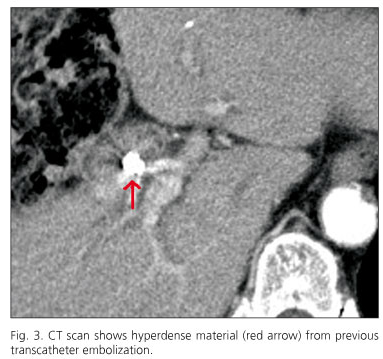Mi SciELO
Servicios Personalizados
Revista
Articulo
Indicadores
-
 Citado por SciELO
Citado por SciELO -
 Accesos
Accesos
Links relacionados
-
 Citado por Google
Citado por Google -
 Similares en
SciELO
Similares en
SciELO -
 Similares en Google
Similares en Google
Compartir
Revista Española de Enfermedades Digestivas
versión impresa ISSN 1130-0108
Rev. esp. enferm. dig. vol.102 no.6 Madrid jun. 2010
PICTURES IN DIGESTIVE PATHOLOGY
Hemobilia after pseudoaneurysm of a right hepatic artery branch
Hemobilia por pseudoaneurisma de una rama de la arteria hepática derecha
B. Arroja1, M. Canhoto1, P. Barata2, C. Gonçalves1, F. Silva1, I. Cotrim1, H. Vasconcelos1, J. Pais2 and V. Pardal3
Departments of 1Digestive Diseases, 2Surgery, and 3Radiology. Hospital de Santo André. EPE. Leiria, Portugal
Case report
A 72 year-old male with previous history of coronary heart disease, diabetes and gallbladder lithiasis, regularly medicated with low dose aspirin and oral anti-diabetics drugs, was admitted at the emergency room complaining of severe right upper abdominal quadrant pain and hematemesis. Physical examination: pallor, BP 110/70 mmHg, HR 90 bpm; tender and distended abdomen and normal cardiac-pulmonary auscultation; normal rectal examination. Laboratory data: haemoglobin 7.5 g/dL, platelet count 230.000/mL, INR 1.05, blood-urea nitrogen 12.3 mg/dL, ALT 130 U/L, AST 130 U/L, ALP 424 U/L.
Esophagogastroduodenoscopy detected blood actively oozing from the papilla of Vater (Fig. 1). Computed tomography scan raised suspicion of an inflammatory aneurysm secondary to acute cholecystitis. Angiography suggested a pseudoaneurysm of a right hepatic artery branch (Fig. 2). Transcatheter embolization was done successfully and a follow-up CT scan performed one month later confirmed hyperdense embolization material in place (Fig. 3).
The patient refused subsequent cholecystectomy.
Two years later the patient presented with acute lithiasic cholangitis. Endoscopic retrograde cholangiopancreatography was unable to retrieve biliary stones despite multiple attempts. The patient eventually underwent cholecystectomy and biliary drainage rapidly improving his clinical situation.
Discussion
Hemobilia is a rare hemorrhagic event that must be taken in consideration when upper gastrointestinal bleeding is suspected (1). Abdominal pain, hematemesis, melena and jaundice are typical features (2).
The major underlying precipitating conditions are hepatobiliary trauma, infectious diseases (colecystitis, liver abscess), neoplasms or vascular diseases (3-4).
Several published reports have provided evidence that interventional radiological techniques are of utmost value in diagnosing and treating cases of hemobilia, namely when pseudoaneurysms of hepatic or cystic arteries are responsible for the hemorrhagic event (4,5).
References
1. Akatsu T, Hayashi S, Egawa T, Doi M, Nagashima A, Kitano M, et al. Hepatic artery pseudoaneurysm associated with cholecystitis that ruptured into the gallbladder. J Gastroenterol 2004; 39(9): 900-3. [ Links ]
2. Maeda A, Kunou T, Saeki S, Aono K, Murata T, Niinomi N, et al. Pseudoaneurysm of the cystic artery with hemobilia treated by arterial embolization and elective cholecystectomy. J Hepatobiliary Pancreat Surg 2002; 9(6): 755-8. [ Links ]
3. Welsch T, Hallscheidt P, Schmidt J, Steinhardt HJ, Büchler MW, Sido B. Management of a rare case of fulminant hemobilia due to arteriobiliary fistula following total pancreatectomy. J Gastroenterol 2006; 41(11): 1116-9. [ Links ]
4. Hidalgo F, Narváez JA, Reñé M, Domínguez J, Sancho C, Montanyà X. Treatment of hemobilia with selective hepatic artery embolization. J Vasc Interv Radiol 1995; 6(5): 793-8. [ Links ]
5. Defrayne L, Vanlangenhove P, De Vos M, Pattyn P, Van Maele G, Decruyenaere J, et al. Embolization as a first approach with endoscopically unmanageable acute nonvariceal gastrointestinal hemorrhage. Radiology 2001; 218(3): 739-48. [ Links ]











 texto en
texto en 




